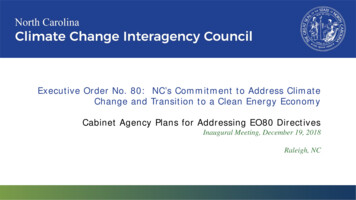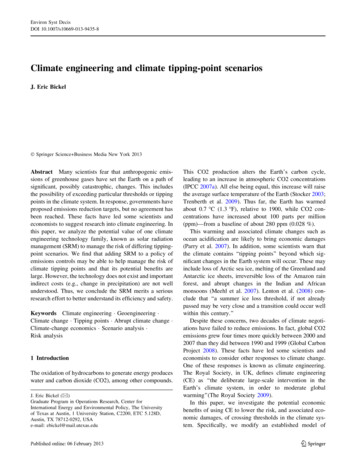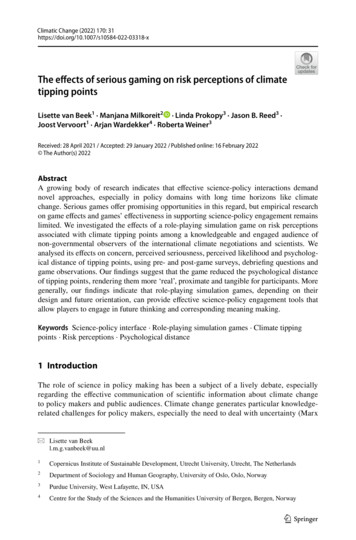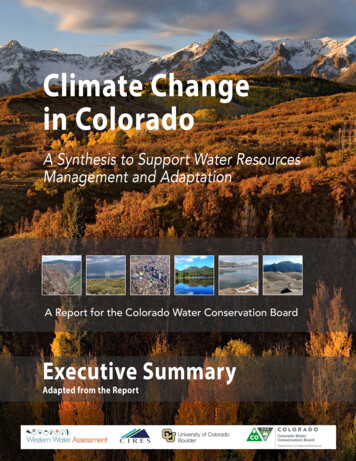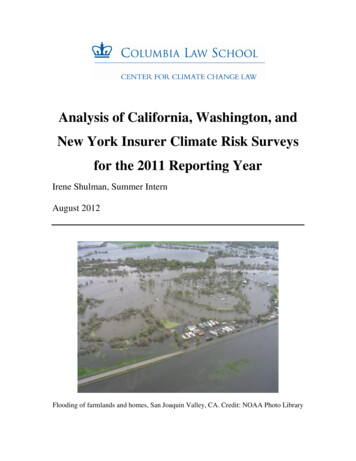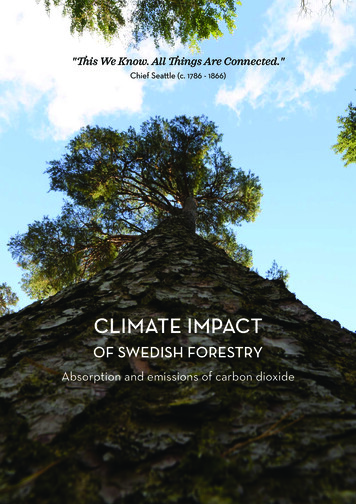
Transcription
"This We Know. All Things Are Connected."Chief Seattle (c. 1786 - 1866)CLIMATE IMPACTOF SWEDISH FORESTRYAbsorption and emissions of carbon dioxide
CONTENTSForeword.3Summary.4Introduction.6Carbon and climate.6Sweden s emissions of carbon dioxide in aninternational perspective.6The carbon cycle – a complicated web in time and space. 7The carbon cycle.8Carbon storage in Nordic forests.9Trees absorb carbon.9Decomposition and burning release carbon stored in biomass.9Carbon stores in production forests in Sweden.10Forest soils as a carbon sink.10Annual net carbon sequestration in Sweden s forests.11Comparison of carbon store in unutilised and production forest.12Forestry systems, silvicultural strategies and carbon balance.12Energy use in forestry.15Carbon dioxide emissions from forestry.15Measures to reduce fossil fuel requirements in forestry.17Forest industry products in a climate perspective. 18Substitution. 19Increasing climate benefit of the Swedish forestand its products. 19References. 20Uppsala Science Park, SE-751 83 UppsalaPhone: 018-18 85 00skogforsk.seEditor: Rolf Björheden, Skogforsk – Translation: Leslie Walke, Communicaid – Layout: Inger Petré, SkogforskPhotos: Rolf Björheden, Skogforsk unless stated otherwise – Print: Gävle Offset 2019ISBN: 978-91-88277-09-1
FOREWORDIn 1896, an article, On the Influence of Carbonic Acid in the Air upon the Temperature ofthe Ground, was published. The author, the Swedish chemist Svante Arrhenius, arguedthat increased carbon dioxide levels in the atmosphere would, in the long term, lead togeneral global warming and a changed climate. He argued that the carbon dioxide levelin the atmosphere was a contributory cause of the Earth’s glacial and warmer periods.His theory was received with great scepticism.However, in recent decades, his pioneering article about the greenhouse effect ofcarbon dioxide has gained strong support. Human activities, on a scale that Arrheniuscould never have foreseen, have added enormous quantities of carbon dioxide to theatmosphere. Levels of carbon dioxide in the atmosphere have increased from less than300 ppm when he conducted his research to over 400 ppm today.The Earth’s climate is driven by interacting processes. The connections are not yetfully understood, but sophisticated models of the global climate and analysis of climatedata strongly support the theory that ‘greenhouse gases’ contribute to global warming.Today, it is accepted that the carbon dioxide levels in the atmosphere is a factor that isinfluencing the climate, through the greenhouse effect.The climate issue is largely a matter of managing and controlling the carbon flows. Thisgives forest management a key role, because forest trees absorb carbon dioxide from theatmosphere and store carbon through their increment. Products based on forest biomassalso store carbon and can reduce the use of carbon from fossil sources. In Sweden, theforestry sector, through its activities, is managing the largest flows of carbon. This is thebackground to this attempt to summarise a large and complicated subject: how Swedishforestry impacts the climate.It is my hope that the reader will learn something new and find inspiration in this text.Uppsala, July 2019Rolf Björheden, SkogforskSkogforskClimate impact of Swedish forestry 3
SUMMARYOne important goal for climate policy is toreduce emissions of carbon dioxide. The forestsector can play a major role in this, and itscontribution is immediate. The current annualincrement in Sweden’s forests correspondsto over three times the country’s emissions ofcarbon dioxide, 53 million tonnes.For greatest effect, net yield must be maximisedand maintained, without neglecting otherobjectives, and goods and energy must beproduced from forest raw materials as faras possible. Forest products already reduceannual emissions by 40 million tonnes throughsubstitution effects, and using more of the felledbiomass would increase the climate benefit by afurther 50%.PHOTO: ERIK VIKLUND4 Climate impact of Swedish forestrySkogforsk
Carbon dioxide levels in the atmosphere have increasedSince 1929, when the first Swedish National Forestryfrom 280 ppm to over 400 ppm in the past century. The mainInventory was completed, the increase in standing volumereason is the extensive use of fossil fuels – coal, oil and naturalequals two billion tonnes of CO2 or approximately 40 yearsgas. When fossil carbon compounds are burned, carbon thatof territorial Swedish CO2 emissions, 53 million tonnes/yr, atwas previously stored is released as carbon dioxide. Higher2016 level.levels of carbon dioxide in the atmosphere are now acceptedForest soils also store organic carbon. The total storageas a driving factor in the rising average global temperatures,of soil carbon, approximately 1 800 million tonnes, exceedsthrough the greenhouse effect.the quantity of carbon stored in growing trees. To this canIn recent years, the forestry sector has come into focus as abe added 510 million tonnes stored in peatland and largeway to counteract increasing carbon dioxide levels. Growingquantities stored in unutilised forests. These storages areforests absorb carbon dioxide from the air. Over time, anot considered here, where the focus is on production forest.significant store of organic carbon accumulates in forestSoil carbon increases only slowly. An average of 7 kg carbon/soils. But how does active forestry affect the dynamics of theha/yr has accumulated in forest land since the last Ice Age,carbon cycle? In this report, forest management strategiescompared with just over 7 tonnes carbon/ha/yr absorbedand approaches are presented and discussed from theannually by the growing forest.perspective of carbon sequestration and mitigation of climatechange.Analyses of the impact of forest management for carbonsequestration show the importance of maintaining high netThrough photosynthesis, using solar energy, green plantsproduction. Extending rotation periods increases the storageconvert water and carbon dioxide to sugar. Trees use the sugarof carbon in the forest but reduces net production. Theseto produce the substances they need for growth and as aneffects often balance each other out. Leaving the forest toenergy source for their vital processes. Oxygen is a residualdevelop naturally, such as by designating reserves, increasesproduct of this process. When a plant dies, its biomass isthe carbon storage, but once the standing volume has reacheddecomposed by organisms that live on the dead biomass,its maximum, net carbon assimilation almost completelyand the assimilated carbon is released as carbon dioxide.stops.A natural plant community is carbon neutral, becauseEmissions of carbon dioxide from forest operations andincrement and decomposition are in balance over time, aparttransports were calculated. Total emissions in 2014 were justfrom a small proportion of organic carbon transferred to theunder one million tonnes of CO2/yr. Silvicultural pre-commercialIn a production forest, this equilibrium is upset. Wood isthinning and fertilisation) account for approximately 60 000extracted for use in products and materials, with varyingtonnes, logging (felling and terrain transport) approximatelylifespans. Biomass is removed, instead of being left to the386 000 tonnes, and road transports, including emissionsnatural decomposers. However, if biomass is used to substituteconnected with forest road construction and maintenance,products or fuels based on fossil carbon, the forest products521 000 tonnes.also reduce the amount of carbon dioxide in the atmosphere.Fuel consumption in forestry was calculated to be 4.71Swedish production forest assimilates carbon dioxidelitres per harvested m3s st. For many consecutive years,each year through increment. The total increment is currentlythe forestry sector has increased energy efficiency in its120-130 million m3s st/yr (stem volume above stump, overoperations. This is a result of technical advances, such asbark). If the total tree biomass, including stumps, roots,more efficient engines, but also through increased awarenessbranches and foliage, is calculated instead of stem volume,of environment and climate issues and a greater focus onthis is the equivalent of 85-90 million tonnes of dry matter,fuel economy. The work to reduce emissions from forestryhalf of which is carbon. One tonne of carbon is the equivalentcontinues. This particularly applies to road transports, whichof 3.7 tonnes of carbon dioxide, so almost 170 million tonnesaccount for over half the emissions.of carbon dioxide are absorbed from the atmosphere eachyear.Managed Swedish forests constitute a significant carbonstore. The standing volume, over 3.1 billion m3s st, correspondsto 4.3 billion tonnes of carbon dioxide. Since harvest is lessthan increment, the carbon store is increasing. The annualincrease can be calculated by deducting the drain (fellingand trees that die from other causes) from the increment. Theincrement, 121 million m3s st/yr, must then be reduced by 96million m3s st/yr (of which 84 million m3s st through harvest).The inventory increase is therefore 25 million m3s st/yr, abiomass equivalent to 35 million tonnes of carbon dioxide.SkogforskClimate impact of Swedish forestry 5
INTRODUCTIONDuring growth, green plants assimilate carbondioxide through photosynthesis and store carbonin their tissues. In a forested country like Sweden,the management of this massive natural resource isof critical importance for the contributions to theinternational work to mitigate climate change.Carbon and climateThe Earth’s climate is the result of interacting processes,are of critical importance for the world’s climate, and arewhose links and effects are still not completely understood.probably more significant than the direct effects of theResearch has shown how the climate has varied over timeatmosphere. Today, we do not know the possible effects of thearound an equilibrium state, with exchanges and interactiveincreasing carbon levels in the oceans. Because of this greateffects between the atmosphere, hydrosphere and geosphere.uncertainty, many people support the principle of caution, i.e.Distinct events, such as major volcanic eruptions, have hadan objective to minimise impact on the natural balance of theclear effects on the climate, which can be interpreted fromcarbon exchange.the archives created through annual sedimentation on thethe models that describe the climate. Human activity hasSweden’s emissions of carbon dioxidein an international perspectivebecome very important in this context, primarily as aSweden is a country with a cold climate, a large manufacturingresult of extensive burning of fossil carbon deposits (coal,sector, and extensive domestic transports. In the 1970s,oil and natural gas), but also through, for example, cementthe country was strongly dependent on fossil energy.manufacture, changes in land use, ditching in peatlands, andEmissions of carbon dioxide were around 10 tonnes perdeforestation. These activities add large quantities of carboninhabitant and year (Figure 1). The ‘oil crisis’ in the mid-dioxide to the atmosphere. An extensive switch of ecosystems1970s showed the vulnerability of the country to disruptionsfrom forest to agricultural land mobilises carbon dioxide,in the energy supply. Ambitious work to improve efficiencyreleasing significant carbon storages in plant biomass andin the energy sector was initiated. Sweden also became athe soil.forerunner in large-scale use of bioenergy, largely basedsea floor and in glaciers.Where and how carbon is stored plays a key role inCarbon dioxide levels in the atmosphere have increasedon forest raw materials. The increased use of biofuels hasfrom 280 ppm during the 19th century to 415 ppm today,meant that the net addition of ‘fossil’ carbon dioxide hascorresponding to 188 billion tonnes of carbon. Carbonfallen further. Total emissions of carbon dioxide in Swedendioxide is a greenhouse gas, which means that increasedfor 2016 were 52.9 million tonnes exclusive of LULUCF1,levels in the atmosphere reduce the amount of solar energy(-42.9 million tonnes) and foreign transports (9.4 millionthat is reflected back into space from the Earth. The result istonnes) (The Swedish Environmental Protection Agencyincreasing average temperature and a changing climate.2018).The equilibrium processes also affect the oceans, whichFigure 1 shows carbon dioxide emissions per capita incontain approximately 50 times more carbon than theSweden, the world, the Eurozone and selected countries foratmosphere (Figure 2). The increasing amount of carbon incomparison. In the 1970s, Sweden’s emissions were morethe atmosphere means that the carbon levels in the oceansthan double the world average. Since then, increased energyare also increasing. However, the oceans have an ability toefficiency and expansion of carbon-neutral energy havemainly throughmore than halved the emissions. The reduction has not beenthe enormous numbers of calcifying plankton. When theat the cost of GNP, which has grown in both absolute andshells from these plankton are deposited as sediment on therelative terms. Sweden’s emissions of carbon dioxide persea floor, the carbon is stored as calcium carbonate in theinhabitant and year are now below the world average andsludge. Over time, these deposits form sedimentary rocksone of the lowest figures in Europe.trap carbon in the form of carbonate(CO2-),such as chalk and limestone. Water movements in the oceans1Land Use, Land-Use Change and Forestry, which describes the effects of land use.6 Climate impact of Swedish forestrySkogforsk
CO2 EmmissionsCO2 emissions,metrictonsper capita tonnes per capita25USA2015RUSFIN10EUROSWEWORLD5CHNBRA0Figure 1. Carbon dioxide emissions per capita 1960-2014 in Sweden, the world, the Eurozone andsome selected countries for comparison. In 2014, Sweden’s per capita emissions of carbon dioxidewere just under the global average. Based on data from the World Bank.The carbon cycle– a complicated web in time and space(carbon accumulates), in balance, or negative (carbon is lost).Forests dominate the Swedish landscape. The country’s 28data from the Swedish Forest Soil Inventory, combined withmillion hectares (ha) of forest form a strong base for culturemodels of processes that contribute to carbon sequestrationand traditions, contribute greatly to the economy of ruraland the carbon cycle.At SLU, the Department of Soil and Environment has built upa knowledge bank about carbon cycle dynamics, based onareas, and make a significant contribution to the balance ofOne difficulty when establishing the carbon balance istrade. In recent years, interest has grown in the ways in whichdefining logic boundaries in time and space for describingthe forestry sector can mitigate the atmosphere’s increasingthe net effects of various measures. Clearfelling forestry,levels of carbon dioxide. Growing forest absorbs and storesdominant in Sweden, extends from harvest and regenerationcarbon in biomass and in forest soils, but how does activeuntil the new stand is ready for harvest. Such a rotation periodforestry affect these processes?is normally 70-110 years, depending on the fertility of the soilNot all forest land is used for production. Of the 28.1and the landowner’s goals. During the rotation period, themillion ha classed as forest land, some 5 million ha arestand passes through different phases and is subjected toexempt from forestry because increment is lower than onevarious measures (e.g. pre-commercial thinning and thinning)cubic metre of stemwood per ha/yr, the limit for productionthat affect both the ongoing increment and the amount offorest. Approximately 1 million ha of production forest islitter2 produced, and thereby the net flow of carbon. Each ofexempt from forestry through formal protection (nationalthese phases can be studied separately, but when the carbonparks, nature reserves, etc.) and a further 1.3 million ha arebalance of boreal forests managed by clearfelling is to bevoluntarily set aside for conservation by forest owners.calculated, the analyses should cover at least one rotationThe amount of carbon stored in vegetation and soilperiod. An alternative approach is to regard the forestry inchanges over time, depending on geographical location,a landscape perspective, where the forest’s distribution inclimate and soil properties. The size of carbon sinks isterms of development phases can be assumed to be relativelyaffected by current and historical land-use practices, mainlystable over time.different forestry and agriculture activities, and whether theThe influence of Swedish production forest on the flownet carbon flow over a certain period and area is positiveof carbon in the biosphere is first presented, followed by2Dead plant parts. In this text, litter has been used as a synonym for detritus, the term used in Figure 2.SkogforskClimate impact of Swedish forestry 7
The carbon cyclea description of the store and flows of carbon. This givesa simplified picture of the carbon dynamics, with figuresCarbon, one of the most common elements, is an importantrepresenting averages for Swedish forest. This is thenbuilding block in all organisms. The carbon cycle (Figure 2)compared with the net sequestration of atmospheric CO2 indescribes the carbon flows in and between the geosphere,a forest that is not actively utilised. Forestry causes release ofbiosphere, hydrosphere and atmosphere. The amount ofcarbon dioxide of fossil origin, mainly in the form of exhaustcarbon in the atmosphere, mainly in the form of carbon dioxide,from motor vehicles and forest machines in connection withis mainly regulated through processes in the biosphere andactivities such as felling, terrain transport, forestry, roadthe hydrosphere. Over a longer time perspective, the amountconstruction and maintenance, and road transports. The sizeof carbon in the atmosphere is determined by the balanceof these emissions is shown, along with how forestry can workbetween sedimentation of calcium carbonate on the seato reduce its emissions. Finally, the different items are totalledfloor, photosynthesis, respiration and decomposition in theto provide a net description of the effects of forestry on thebiosphere, weathering of rocks, and emissions from volcaniccarbon balance within Sweden’s national boundaries.activity. This balance is now being increasingly affectedThe aim is to show how active forestry affects the dynamicsby human activities, mainly when land use is switched toin the carbon cycle. Strategies that may increase the capabilityagriculture and when biomass and fossil deposits of carbonof forests to absorb and store carbon, as well as managementare burned for energy recoveryapproaches that are less successful from this perspective, arepresented and discussed.Atmosphere 597 ( 165)1.6119.6Respira on6.4Land usechangeGrossprimaryproduc onLand sink70.622.22.6120Weathering0.20.40.2RiversVegeta on Soiland Detritus2300 ( 101 -140)Weathering7020Surface Ocean 0–500m0.8 900 ( 18)39101MarReservoir sizes in GtCFossil fuels3700 (-244)ine50Biota31.62.900)eep 0 ( 10Dd0an71iate 5 0 0 m 3determ n 11 In OceaS ur fa0. 2 e nt 1 5 0edimce sFluxes and rates in Gt C/yrFigure 2. The carbon cycle and its global flows (after IPCC 2007). Blue figures show storages (reservoirs) in Gt (billion tonnes) of carbonand flows in Gt carbon/year before industrialisation, around 1750. Red figures show the effect of human activities on storages and flows,around 2005.8 Climate impact of Swedish forestrySkogforsk
CARBON STORAGE INNORDIC FORESTSTrees absorb carbonAlready in the first billion years of life on Earth, cyanobacteriaA carbon dioxide molecule comprises one carbon atom, withor blue-green algae developed the ability to utilise solarthe atomic mass 12, and two oxygen atoms with the atomicenergy to enrich water for their vital processes. According tomass 16. The molecule has an atomic mass of 44, of whichMargulis & Sagan (1986), the photosynthesis that occurred with27.3% comprises carbon (Figure 3). One kg of dry woodthe bacteria, leading to the green plants absor bing carboncomprises, on average, approximately 0.5 kg carbon. In thedioxide, was "undoubtedly the most important single metabolicformation of this amount of wood, 1.83 kg carbon dioxideinnovation in the history of life on the planet". Trees capture and(0.5/0.273) has been assimilated in the tree’s biomass.assimilate atmospheric carbon in the form of carbon dioxide,while also releasing oxygen, shown in chemical form as6 H2O 6 CO2 light energy C6H12O6 (dextrose) 6 O2Some of the energy is used for cell respiration, but largequantities of carbon are stored in plant biomass through netincrement. Carbon is absorbed and assimilated by the greenparts of the trees, and stored in the form of hydrocarbonssuch as cellulose, hemicellulose, lignin and starch. Over time,most of the stored carbon is found in the woody parts of thetrees, i.e. in stemwood, branches, twigs and roots.Approximately half of the dry weight of the trees comprisescarbon, although the proportion varies between differenttree species. Conifers generally contain slightly more carbon(47-55%) than deciduous trees (46-50%), mainly because of ahigher average lignin content, approximately 30%, comparedwith 20% for deciduous trees (Lamlon & Savidge 2003).Decomposition and burning releasecarbon stored in biomassLitter, i.e. dead plant parts in the form of branches, leaves andneedles, along with stumps, branches and tops that are leftbehind after felling, is gradually broken down by organismsthat live on the nutrients and energy they can release fromthe biomass. The biomass is decomposed to carbon dioxideand water, and the stored carbon is released back to theatmosphere.Decomposition takes varying amounts of time, dependingon the type of biomass. Nutrient-rich and smaller plantparts, such as leaf litter, needles and twigs decomposefaster than thicker, woody plant parts. Ambient conditions– mainly temperature and access to water and oxygen –are particularly important for the decomposition process(Li et al. 2007). Under damp but anaerobic conditions, thedecomposition process is very slow, as shown in peatlands.Decomposition is also slow in dry ecosystems.Figure 3. The carbon dioxide molecule comprises two oxygenatoms, with the atomic mass 2 x 16, and a carbon atom with theatomic mass 12. Carbon dioxide comprises 27.3% carbon.SkogforskClimate impact of Swedish forestry 9
SOME MEASUREMENT UNITS OFFOREST AND WOODTop (cut at 5 cm)Stem volume over bark (m3s st)The volume of the entire stem and itsbark, above stump height.Solid volume under bark (m3s ub)The volume of the stemwood, excludingthe bark and top.Branches and foliageApprox. 20% of the biomassCubic metres of biomass (m3s biom)The volume of the entire tree, includingbranches, needles, stumps and roots.Stem and barkApprox. 55% of the biomass, ofwhich top 5% and bark 12%Tonnes of dry matter (tDM)The weight of the biomass when it hasdried. Approximately half of the weightof the living tree is water, and half of thedry matter comprises carbon.Stump and root systemApprox. 25% of the biomassFigure 4. Some of the units of measurement of forest and wood used in this text.Carbon stores in production forestsin SwedenBased on information from the National Forest Inventory,which publishes statistics on Sweden’s forests (Skogsdata2017), biomass in living trees comprises 2 685 million tonnesdry substance, 86% of which is in production, non-protectedforest. Approximately 55% of the biomass consists ofstemwood and bark and nearly 20% in branches, leaves andneedles. The remaining 25% is biomass in the stump-rootsystem.Forests also contain a significant amount of dead wood(223 million m3s st), approximately 5-9% of the standingvolume over the whole country. The amount of dead woodis increasing, so the drain from living forest is greater thanongoing decomposition. A probable cause is that harvestof dead trees in large-scale forestry has virtually stopped.Instead, dead wood is deliberately created, in the form ofhigh stumps as a measure to improve conditions for wooddependent organisms (Skogsdata 2016). However, the rate ofincrease is slow, and an equilibrium point will be reachedwhen the proportion of dead wood becomes quite constant.Converted into carbon, approximately 1 160 million tonnesof carbon are currently stored in living trees in Sweden’sproduction forests, and a further 100 million tonnes ofcarbon in the form of dead wood.Forest soils as a carbon sinkSome of the carbon is transferred to the ground, and largequantities are stored in the soils of forest land. Land that haspreviously been forested, but that is now used for agriculture,leaks carbon to the atmosphere, but if the land is reforested,this process is reversed and the storage of carbon once againincreases (Post & Kwon 2000). Such a process can also beobserved after clearcutting. Initially, soil carbon increaseswhen stump-root systems and other logging residues that areleft after harvest are decomposed, but the amount of carbonstored in the soil can then fall somewhat, at least on fertilesoils (Stendahl 2017). Approximately at the time for a firstthinning (20-30 years), the soil carbon has once again reachedthe level it had before the previous harvest. The reason for thedecrease in the carbon storage in the soil seems to be mainlythe small amount of litter in the young forest phase, comparedwith the conditions found in a mature forest (Stendahl 2017).Stendahl et al. (2010) used fixed plots of the National ForestInventory to investigate the amount of soil carbon down to adepth of 100 cm in the soil profile. The study was carried outon species-pure plots of Norwegian spruce and Scots pine onfresh to moist podzol on sandy or finer soils. The amount ofsoil carbon was found to differ between the spruce and pineplots. On pine plots (n 188), the average amount of soil carbonwas 57 tonnes per ha, while the spruce plots (n 144) containedan average of 92 tonnes of soil carbon per ha. The differencebetween the species was less in better climate regions (Figure5).10 Climate impact of Swedish forestrySkogforsk
25Schlesinger (1990) studied the long-term storage of carbon inSpruce plots (0 — )Pine plots ( –––)soils with a geological age of up to 12 000 years, i.e. land thathas become exposed through the melting of glaciers sincethe most recent Ice Age. He found that carbon continuallySoil organic carbon (SOC) stock [kg m2]20accumulated during this period, and that the process is stillgoing on. The rate of sequestration is affected by climate,vegetation, the way the land has been used, and other factorssuch as storms and forest fires. The speed of the process varies15greatly, from 2 kg carbon/ha/yr in arid tundra areas, up to 100kg carbon/ha/yr on the most fertile forest land. The averagefor the ecosystems studied was 24 kg carbon/ha/yr.10The average storage of carbon on Swedish forest land,75 tonnes of soil carbon per ha, has accumulated since themelting of the glaciers, a period of approximately 11 000 years(Figure 6). This means that the sequestration rate on Swedish5forest land has been around 7 kg carbon per hectare and year.Although the sequestration process is not linear and has largevariations, this figure is used to describe the development ofthe carbon store on Swedish forest land.0400600800 1000 1200 1400 1600Temperature sum [degree days]1800Figure 5. Linear regression of measured soil carbon (SOC) perm2 to 100 cm depth. The difference between the tree speciesdecreases with increasing temperature sum. Average values foreach tree species are shown by red symbols. After Stendahlet al. 2010.An interpolation of the data in Stendahl et al. (2010) suggeststhat the average storage of soil carbon in Swedish forestland is approximately 75 tonnes per ha, down to a depthof 100 cm. This indicates a total soil carbon storage inSwedish production forest land of some 1 800 million tonnesAnother 510 million tonnes of carbon are stored in peatlandforests (Stendahl 2017). The carbon storage in Sweden’sapproximately 7 million hectares of unutilised forest land,tree and bush land, is not calculated, since this area is notaffected by forestry activities. However, also on these landuse categories, significant quantities of carbon are
Uppsala Science Park, SE-751 83 Uppsala Phone: 018-18 85 00 skogforsk.se. CONTENTS . Rolf Björheden, Skogforsk. 4 Skogforsk SkogforskClimate impact of Swedish forestry 5 . Water movements in the oceans are of critical importance for the world's climate, and are .





